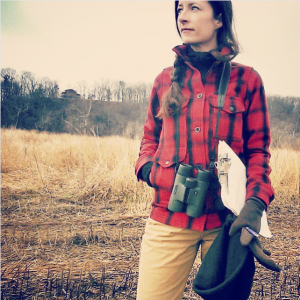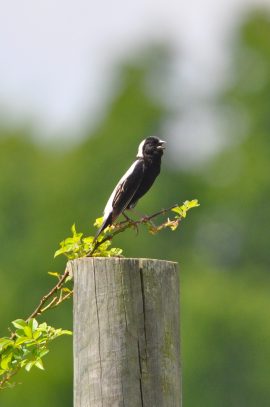By Eric Wallace

Blue Grosbeak at Oxbow Farm CO Amy Johnson
Grassland birds are among the most under-researched of North America’s avian species. Virginia Working Landscapes, a partner of the VABBA2, is making the Commonwealth a template for conservation.
Virginia Working Landscapes (VWL) program director Amy Johnson has devoted her life to round-the-clock birding for nearly a decade. Since 2012, the 37-year-old Ph.D. has been recruiting, training, and leading an ever-growing team of citizen-scientist birders to learn more about avian breeding activity in the Commonwealth’s grasslands. From 2012-2015 alone, she oversaw more than 3,000 field-hours of research—including 1,800 surveys conducted at more than 200 points across 16 counties.
“Birds that depend on grass- and shrubland vegetation for survival have experienced a steeper, more consistent decline than any other group in North America,” says Johnson. Results from 40 years of breeding bird surveys showed declines in 32 of the continent’s 37 species. Meanwhile, about 80 percent of native grassland ecosystems have disappeared. In terms of reversing declines among grassland birds, she says, “One of the biggest challenges we face is a lack of information about the precise cause(s) of the problem or the most effective solutions. Therefore, field research [about these birds and their habitat] is critical.”
Ahead of the launch of the VABBA2, Johnson began working with Ashley Peele (VABBA2 coordinator) to train volunteers to double as Atlasers. Given the projects’ overlapping agendas—to gather data on breeding birds—joining forces seemed obvious. As a public-supported nonprofit, VWL would benefit from additional exposure and contribute to a statewide dataset. The Atlas would gain a motivated team of birders with established connections in rural communities.

Amy Johnson, VWL Program Director
“From an avian conservation standpoint, this work is extremely high-priority,” says VABBA2 director Ashley Peele, Ph.D. “Affecting changes that will help keep these birds around for generations to come starts with good data. And we couldn’t ask for a better partner to help us achieve that goal.”
Johnson’s work with VWL is part of an ongoing initiative at Front Royal’s Smithsonian National Zoo & Conservation Biology Institute. In addition to breeding surveys, the project is producing targeted information about how conservation and land management practices influence our region’s biodiversity. This includes the study of vegetation, soil and pollinator communities, in addition to breeding and wintering birds.
Peele says one reason for the lack of data surrounding grassland birds stems from a common misperception: Drive down rural Virginia byways and you’ll find an abundance of healthy-looking habitat. But appearances can be deceptive. Though grass- and shrub lands are characterized by open space and feature a patchwork of grass and forb groundcover, the particular mix and variety of plants can differ greatly by location.
For instance, most of today’s pastures are monocultures comprised of non-indigenous European grasses. Celebrated for centuries, their bucolic appearance belies their unnaturalness. Widespread implementation—and various management practices thereof—has been linked to avian declines.
“Agriculture and development have altered native ecosystems dramatically,” says Peele. Less than 20 percent of grasslands remain unmodified nationwide—and Virginia is no exception. “Whether positive or negative, any form of land management activity brings an effect.”
From prescribed burning, seasonal mowing, livestock grazing, pesticide or herbicide use, to conservation buffer planting, these things all influence bird populations to varying degrees and in varying ways.
“Species like Loggerhead Shrike and Bobolink are dependent on specific conditions and types of vegetation,” says Peele. The latter nest in the tall grasses of overgrown fields and meadows. The former, in fields interspersed with thorny shrubs. Monocultural pastures, early or frequent mowing (i.e. for hay or landscaping), and urban sprawl have greatly reduced the prevalence of such habitats. The losses place pressure breeding activity.
On the other hand, Johnson says that “establishing conservation buffers increases the number and diversity of species in an area, and also improves nest success for several species.”
“At this point, we need to learn how various kinds of changes are affecting specific populations and their distribution,” says Peele. Knowing where birds are doing well, and in what kinds of conditions helps conservationists locate, protect, and strengthen existing best management practices for critical habitats. “Studying such areas helps us develop management protocols that can be replicated elsewhere.”

Bobolink (CO Amy Johnson)
But achieving that goal isn’t so easy. Progress has been complicated by the fact that more than 85 percent of Virginia’s remaining grassland habitat is located on private property—mostly in rural areas. Gaining access requires building trusting relationships with landowners, which takes time. With government agencies stretched thin, the combo can make data acquisition seem like a pipedream. Peele says this is, at least in part, what makes Johnson and the VWL such a valuable partner and resource.
“Our overall aim is to survey properties that span a broad spectrum of land management approaches so that we can begin to gain a better understanding of how management directly impacts our region’s biodiversity,” says Johnson. “We can’t accomplish this without these generous landowners who are willing to accommodate our survey teams on their land. From them, we gain a unique perspective on the conservation issues that drive their efforts and, as a result, we are constantly learning new information that helps shape our research program.”
Responses have been overwhelmingly positive. Johnson says birds—especially rare ones—make surveys an easy sell. Beautiful and recognizable, they offer a visual connection to the land. As landowners become more familiar with the diversity of species using their land, they take increased ownership for their welfare. Questions about making the property more avian-friendly typically follow. And the interest doesn’t stop there: Learning about birds often leads to other wildlife, including the plants and insects that support them.
For Johnson, the pattern has been both unexpected and enlightening.
“It’s incredibly encouraging to see how much these landowners care,” she says. Given proper information, landowners frequently volunteer to implement changes—especially those requiring minimal financial investment. “It’s amazing to see how much actionable impact is coming from simply creating awareness,” says Johnson. “We’ve learned that lots of landowners want to be better land stewards, they often just don’t have the tools. As conservationists, we need to start finding more and more innovative ways to bridge that gap.”
Accordingly, Peele says data gathered by citizen scientists about grassland birds could lead to recommendations for updated species-specific conservation management strategies.
“The VWL has shown how much can be achieved for grassland bird species by working with private landowners,” she says, adding that a statewide grassland conservation initiative would be a huge step forward.
Such an initiative would include commitments from landowners to delay mowing on at least 20 acres until July 15 of each year. (That gives birds a location and the time necessary to breed and fledge chicks.) A certain percentage of properties would be maintained as pesticide-free. Various parcels would be rehabilitated to conservation buffers of native shrubs and grasses.
But for that to happen, funding from government agencies, foundations, and organizations is necessary. And that’s why vocal public interest and support is so vital.
“For now, our goal is to continue raising awareness and educating around this issue, and get the public to think differently about grasslands,” says Johnson. “We place tremendous emphasis on forests—and that shouldn’t stop—but these habitats are equally important. Sadly, this something most people aren’t aware of.”
And if we want to keep grassland birds around, that has to change.
CALLING ALL ATLASERS:
Though the VABBA2 currently has fairly strong data for grassland species breeding in the northwestern part of the state, we’re lagging elsewhere. For many grassland areas in southwest Virginia and the southern Piedmont, data is almost nonexistent.
“This season, we’re asking as many volunteers as possible to travel and help out in those areas,” says program director Ashley Peele, Ph.D. A handful of volunteers committing to a few days of blockbusting can make all the difference. “Getting Atlasers into these under-birded priority blocks is imperative to the success of the VABBA2. For our data to have validity, it has to be statewide. If we neglect these locations, that doesn’t happen.”
To learn more about how you can help, email Ashley Peele directly at: ashpeele@vt.edu


